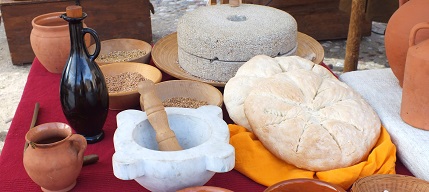What is the garum?
Many certainly will have heard of garum, and for sure it will remain what it was incuriositi.Ma garum? A fish sauce marinated in salt, some say nauseating smell, the Romans included the rich many of their dishes.
The word is of Greek origin and garum indicated in principle a fish or a category of fish for the preparation of this particular condiment produced by maceration of some fish at the hands of their own enzymes, in the presence of salt in antiseptic function; was a condiment high protein, composed of amino acids, immediately assimilated by the body.
The sources known to us give us the impression that our garum is something really unpleasant smell: Plato called it putrid, Pliny "scum of things rotting." Marziale7 even in his epigram suggests that the breath of his acquaintance Papylus was really unbearable writing: "There was the smell, content just now in a jar onyx;
after Papylus sniffed, became garum! "
In another epigram Marziale8, although it seems to make matters worse with the alleged smell of garum, says something very important: "Thais have a smell worse than the old pot of a miser washer, just broken in the road; that of a young goat after mating, the mouth of a lion, the skin of a dog skinned beyond the Tiber, a rotting chicken in an egg abortifacient, an amphora vitiated by garum gone bad ... "
I must confess that I too after reading the first description I thought how different it was the taste of the ancients from our own, and as justly as they had said: de gustibus non est disputandum! This way I see things lasted until I moved from theory to practice, that is when I decided to do archaeological kitchen and started to experiment with the dishes described in De Re coquinaria so I had to play it.
The first thing you have to ask yourself is: But garum is, invention of the Romans? No it is not their invention, if we go back we find in Greece, we find him in Cartaggine who wielded the production and commercialization until the Second Punic War, and if we go further back we find the third millennium BC in Mesopotamia where the inhabitants of the land between the two rivers were using seems a fish sauce called Alusa kud. But because the Romans would have considered an expensive delicacy what appears to be a crap taste and smell nauseating? Who today would dream, or only recommend, as did Apicius in his recipe, put no sparingly that sauce on almost all dishes, from appetizers to desserts, on meat dishes such as fish, and vegetables?
We must therefore ask what happens when we put the fish in the salt? E 'was made for centuries with both the fish with the meat because the salt dries and allows them to retain data for a long time. Even today, if we think about it we have a prime example the production of salted anchovies, from which to derive the famous Cetara anchovy that many mistake for garum, but is it? It is true in part, in the sense that the principle is the same but the workmanship and the result is different.
How to prepare garum? They came up to us several recipes these are some: In Geoponiche (20, 46, 1 et seq.), We do not know the author and the precise date, we read, throw in a container entrails of fish and small fish small facts salt the sun and mix them frequently; once you get the brine filter all in a basket, where it remains the solid part, the Allec. Some also add old wine to the extent of two sextants for each sextant fish. If you need to use immediately garum not keep much in the sun, it cooks quickly placing the fish in seawater concentrated so that an egg will float, until it is reduced enough volume, then you cola. But the flower of garum you get with the entrails, blood and serum of tuna above which spreads salt and you marinate for two months.
Perhaps the most effective and accurate seems recipe Gargillo Martial (62) that you put in a pot well tinned fish in fatty meats like salmon, eels, shads, sardines, and dried herbs and salt, alternating layers of various ingredients. It closes with a lid and let stand for seven days; within twenty days is mixed through and at the end he collects the liquid. But the more complete treatment of this product so special is offered to us by Pliny the Elder (Naturalis Historia 31, 93 et seq.), Which enumerates the garum between saline substances, as a "liquor exquisitus" produced by maceration in the halls of the intestines fish: here comes the tale of garum as "rotten materials rotting", because the fermentation was confused with rot. In fact at the time of Pliny, were made of tinned fish and knew the methods to make them, without realizing the mechanism of preservation of salted fish.
Where still producing garum? Pliny in chapter 95 says: Today garum finest get mackerel farms Carthage Spartaria is called garum 'Meeting, with a thousand gold if they buy almost two wholesale wine. No liquid, except for perfumes, begins to have higher price, even among people of a certain rank. Even the Mauretania and Carteia the Betic catch mackerel that come from the ocean, and that are not useful to others. They are famous for garum also Clazomene, Pompeii and Leptis: as for the brine (muria) Antipolis and Turi, and indeed even the Dalmatian "The news of this intensive fishing, production and trade of garum there is also confirmed by the geographer greek Strabone6, who reported:
"Then there is the island of Hercules just around Carthage, which is called Sgombraria for catching mackerel, which produce garum better ..."
He also traded a kind of garum without condiments, gari flos itself, and made a kind of fish flakes, garum castimoniale.
Plinio, libro XXXI, 95: Nunc e scombro pisce laudatissimum in Carthaginis Spartariae cetariis: Sociorum id appellatur, singulis millibus nummum permutantibus congios fere binos. Nec liquor ullus paene praeter unguenta maiore in pretio esse coepit, nobilitatis etiam gentibus. Scombros quidem, et Mauretania Baeticaeque Carteia, ex Oceano intrantes capiunt, ad nihil aliud utiles. Laudantur et Clazomense garo, Pompeiique et Leptis: sicut muria Antipolis ac Thurii, iam vero et Dalmatia.
Strabone, Geografia, libro III, cap 4,6: Εἶθ’ἡ τοῦ ῾Ηρακλέους νῆσος ἤδη πρὸς Καρκηδόνι, ἢν καλοῦσι Σκομβραρῖαν ἀπὸ τῶν ἁλισκομένων σκόμβρων, ἐξ ὧν τὸ ἄριστον γάρον…
Geoponica, libro XX, cap 46: Γάρων ποίησις. Τὸ καλούμενον λικουάμεν οὕτω γίνεται. τὰ ἔγκατα τῶν ἰχθύων βάλλεται εἰς σκεῦος, καὶ ἁλίξεται: καὶ λεπτὰ ὀψαρίδια, μάλιστα δὲ ἀθερίναι, ἤ λεπτὰ τριγλία, ἤ μαινίδια, ἤ λυκόστομοι, ἤ ὁ ἂν δόξῃ λεπτὸν εἶναι, πάντα ὁμοίως ἁλίζεται, καὶ ἐν ἡλίῳ ταριχεύεται πυκνῶς δονούμενα. ὅταν δὲ ταριχευθῇ τῇ θερέᾳ, ἐξ αὐτῶν γάρος οὕτως αἴρεται. κόφινος μακρὸς πυκνὸς ἐντίθεται εἰς τὸ μεστὸν ἀγγεῖον τῶν προειρεμένων ὀψαρίων, καὶ εἰσρεῖ τὸ γάρος εἰς τὸν κόφινον, καὶ οὕτω διὰ τοῦ κοφίνου διηθηθὲν τὸ καλούμενον λικουάμεν ἀναιροῦντα: τὸ δὲ λοιπὸν πάτημα γίνεται ἄλιξ
Confectio liquaminis quod oenogarum vocant. Capiunt pisces natura pingues, ut sunt salmones et anguillae et alausae et sardinae et aringi, et fit ex eis atque ex herbis odoratis aridis cum sale compositio talis. Praeparatur vas solidum ac bene picatum capax trium vel quattuor modiorum, sumunturque herbae aridae bene olentes tam de horto quam de agro, utputa anetum coriandrum feniculum apium satureia sclareia ruta menta sisymbrium ligusticum puleium serpillum origanum vettonica argemonia, et ex his in fundo vasis primum ordo consternitur. Tum ex piscibus si minores fuerint integris, si maiores in frusta concisis alter ordo componitur. Super hunc tertius ordo salis binos digitos altus adigitur. Atque in hunc modum his tribus herbarum et piscium salisque ordinibus supra invicem alternantibus vas est usque ad summitatem implendum, tum addito operculo claudendum atque ita per dies semptem dimittendum. Quibus transactis per continuos viginti dies cottidie bis vel ter palo ligneo in modum remi formato compositio ista usque ad fundum est commovenda. Quibus expletis liquor qui de hac compositione defluxit colligitur atque in hunc modum ex eo liquamen vel oenogarum conficitur. Sumuntur huius liquoris sestarii duo et cum dimidio boni vini sestario commiscentur, tum quattuor herbarum aridarum singuli manipuli in hanc mixturam coiciuntur, aneti videlicet et coliandri et satureiae atque sclareiae. Faeni graeci quoque seminis pugillus unus adigitur., et de aromatibus piperis grana triginta vel quadriginta, costi pondo denari tres, cinnami similiter, caryophylli similiter. Haec minute contrita eidem liquori permiscentur. Tum vel in ferreo vel in aereo vase compositio haec tam dium coquenda est quousque ad unius sestarii mensuram perveniat. Prius tamen quam percoquatur mellis despumati selibram in eam adici oportet. Quae cum percocta fuerit more potionum per saccum colari debet usque ad claritatem, fervens tamen sacco infundenda est. Eliquata vero et refrigerata in vaso bene picato servatur ad obsonia condienda.
A other curiosity is that Garum sociorum being essentially a brine saturated sodium chloride in the presence of proteolytic enzymes, as well as being a good digestive, presented as disinfectants, comparable to the iodine and mild anti-inflammatory. So it was used as a medicine against scabies in sheep, recent burns, bites of dogs and crocodile, to heal ulcers, dysentery and ear ailments.

|

